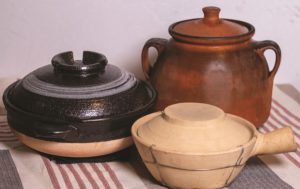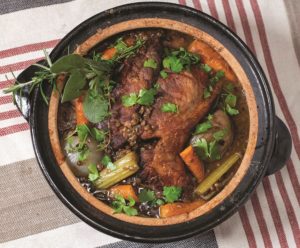Thoreau got lots right. An end-of-August journal entry he made in Concord in 1853 still resonates: “Live in each season as it passes; breathe the air, drink the drink, taste the fruit, and resign yourself to the influences of each.”
As cool fall nights come to the Cape, it’s time to think about braising — a patient way of cooking that coaxes the best out of well-worked cuts of meat, like chuck roasts, lamb shanks, and short ribs. These cuts have more resilient connective tissue, but also more flavor.
One of these, Boston butt, has a name that seems like an anatomy riddle created by an impish butcher. It’s pork, cut from the shoulder, not the rear. Consult the internet if you want to go down the rabbit hole where cooks debate how it came to be called “butt.” What matters here is that the cut is high on the hog shoulder, nicely marbled, and usually includes a bone. These qualities make it ideal for taking the slow gentle track to tenderness.
Beans are a classic pairing with pork: cassoulet, feijoada, pork and beans — I love them all. I admit to nabbing that little cube of seasoned fat from the B&M beans my Ganny served every Saturday night while she listened to the Red Sox. But this version is a long way from what she got when she opened that jar. Ganny would have called my pork shoulder with petite French lentils fancy. I wouldn’t go that far, but it is more bistro than canteen.

Experienced cooks recommend waiting until beans soften to add acidic ingredients like vinegar, wine, or tomatoes. I break this culinary tenet and use it to my advantage with lentils. The lentils in this recipe would slump into a puree during the two hours it takes the pork to get fork tender; by adding red wine from the start, you will get very tender lentils that hold their integrity.
I have had a few bean epiphanies in my life. One of them happened on the small Greek island of Sifnos, where chickpeas are cooked in an unglazed clay beehive-shaped pot called a skepastaria. On Saturdays, just before dusk, women there would bring their pots of chickpeas to a large outdoor oven. While they chatted, the men stoked the fire with dried mountain shrubs. The pots, each with its unique patina from years in this shared cookery, were then packed and sealed into the oven to simmer overnight.
The next day, after Sunday Mass, the women retrieved their pots. Beans cooked this way, with a hint of smoke, a drizzle of extra-virgin olive oil, and a squeeze of lemon, are truly heavenly. I cradled my skepastaria on my lap on the 14-hour flight home.
You don’t have to go to Greece to find a good clay pot for braising beans. I have used a Römertopf clay baker, Chinese rice pots, and New England bean pots found at yard sales. Online you’ll find a treasure trove of them. Dutch ovens like the enameled Le Creuset pots are good for braising, too. Any heavy pot with a tight-fitting lid will work. The main thing is that baking the beans and pork this way is different from setting them on a slow stovetop simmer. When you braise in the oven, beans of all varieties turn out creamier and meats cook more evenly. And oven braising is effortless. The fact that it allows you some laziness is part of its charm.
As I snuggle the pork and vegetables into my favorite pot for the first braise of the season, I think of all the potters who live here on the Outer Cape and wonder if we could start an everything-old-is-new-again communal bean cooking tradition of our own. I’ll have plenty of time to ponder that while my fancy pork and beans braise.
Red Wine–Braised Pork With French Lentils

Serves 4 to 6
2 Tbsp. oil
3 lbs. bone-in pork shoulder
Kosher salt
Black pepper, freshly ground
2 onions
3 whole cloves
3 carrots
2 stalks celery, with leaves
4 cloves garlic
2 cups dry red wine
¾ cup French lentilles du Puy
1¼ cups water
1 bay leaf
1-2 sprigs each thyme, rosemary, and sage
Chopped flat-leaf parsley
Before you start cooking, rinse and pick over the lentils, smash and peel the garlic, and tie the herbs in a bouquet. Heat the oven to 350 F.
Heat a medium-large Dutch oven (or, if using a clay pot, you’ll start the searing in a large skillet and transfer everything to the pot later) over medium-high heat and swirl in the oil. Season the pork all over with salt and pepper.
Sear the pork, turning it until it’s brown on all sides, about 10 minutes. Set aside on a plate. Meanwhile, halve the onions and stud them with the cloves, and cut the carrots and celery into thirds.
Add the vegetables and garlic to the pan, season with salt and pepper, and brown, stirring occasionally, about 5 minutes. Add the wine, scraping any browned bits off the pan with a wooden spoon. (If using a clay pot, transfer the pork, wine, and vegetables to the pot now.) Snuggle the roast in the vegetables in the Dutch oven.
Add the lentils, water, and herbs to the pot. Season with 2 teaspoons kosher salt and a few good turns of fresh-ground pepper. Cover the pot and transfer it to the oven. Braise until the meat is tender, about 2½ hours. When the meat is very tender, uncover the pot and raise the oven temperature to 400 F, letting everything cook until slightly glazed, about 15 minutes. Just before serving, stir the parsley into the lentils.



